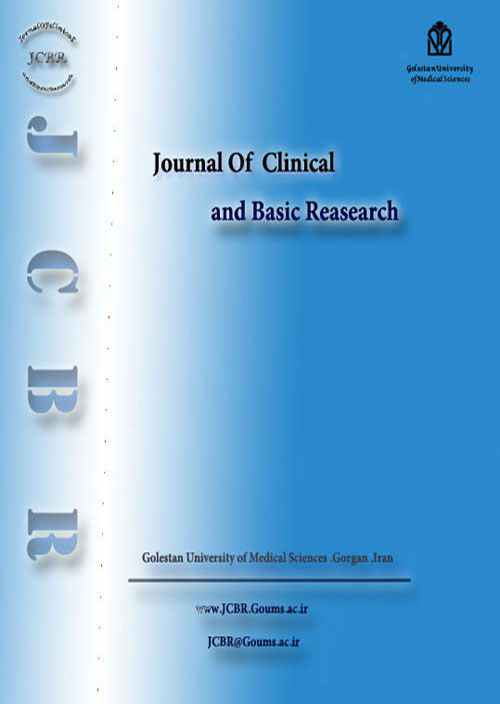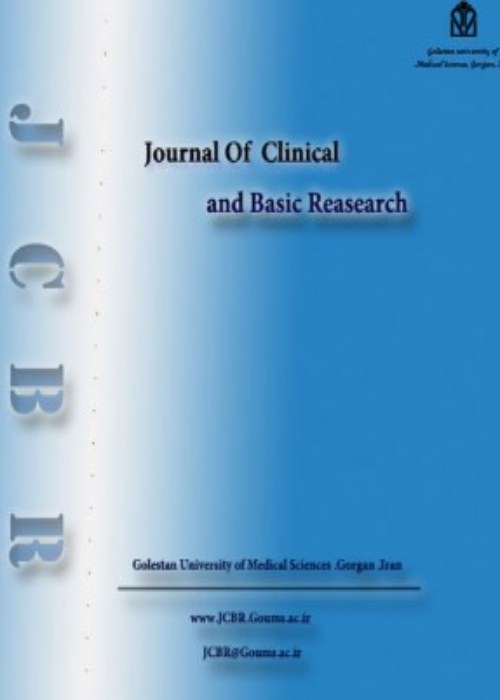فهرست مطالب

Journal of Clinical and Basic Research
Volume:5 Issue: 1, Winter 2021
- تاریخ انتشار: 1400/02/01
- تعداد عناوین: 5
-
Pages 1-6Background
The oral-facial-digital (OFD) syndrome is a group of hereditary disorders, manifested by anomalies of the oral cavity, face and digits that may be associated with cerebral malformations and polycystic kidney disorder. The condition is associated with either X-linked or autosomal recessive inheritance. Herein, we report a case of OFD syndrome with various manifestations.
Case description:
The case was a female baby with the features of the OFD syndrome. The family history was negative. The baby was the product of a non-consanguineous marriage. Diagnosis of OFD syndrome was confirmed by chromosomal microarray. The case had features of OFD type 1 in addition to central nervous system abnormalities. The chromosomal study of the parents was normal. Consultation with the related subspecialties were requested for management of the case.
ConclusionOFD syndrome is a very rare conditions, which can be easily diagnosed. Cooperation of the related subspecialities is very important for better management of these cases
Keywords: Anomalies, Oral-facial-digital syndrome, X-linked, neonates -
Pages 7-14Background and objectives
Intraoperative awareness is accidental or unintentional awareness during general anesthesia that occurs when complete anesthesia has not been achieved. The aim of this study was to investigate the occurrence of awareness with recall during general anesthesia in opium-addicted and non-addict patients undergoing abdominal and pelvic surgeries.
MethodsThe study population consisted of patients undergoing abdominal and pelvic surgeries under general anesthesia in two hospitals in Gorgan, Northeast of Iran. Data were collected 20-36 hours after the surgery using a three-part questionnaire on demographic information, surgery and anesthesia details and anesthesia awareness and recall of events. Data were analyzed in SPSS (version 18) using the Chi-square test.
ResultsOf 206 patients, 53.9% were male and 56.3% were undergoing abdominal surgery. None of the patients in the two groups felt hearing, pain, cold or heat during anesthesia, and neither of them dreamed or recalled any event during the anesthesia and surgery period. There was no statistically significant difference between the two groups in terms of anesthesia awareness with recall. According to the patients, the night before the operation, opium addicts were more anxious the night before the surgery and felt more pain right after the surgery.
ConclusionThere is no statistically significant difference in terms of occurrence of anesthesia awareness between opium-addicted and non-addicted patients undergoing pelvic and abdominal surgeries. However, opium addicts experience significantly higher level of anxiety the night before surgery compared to non-addicts. In addition, opium addicts experience more pain immediately after recovery.
Keywords: Anesthesia Awareness, Recall, General anesthesia, Opium addiction -
Pages 15-23Background and objectives
Reference values of blood urea nitrogen (BUN), serum creatinine (sCr) and BUN to creatinine ratio (BCR) in the different pediatric populations are not well-established yet. The aim of this study was to determine reference values of BUN, sC and BCR in healthy Iranian children.
MethodsThe study included 3268 children (1670 males and 1598 females) who were hospitalized at Ali-Asghar Childrenchr('39')s Hospital (Tehran, Iran) between April 2016 and May 2018. The subjects were stratified into three age groups: toddlers, developing children and adolescents. Demographic data, medical history and laboratory findings were extracted from medical records of the subjects. Statiscal analyses were peformed using SPSS at statistical significance of 0.05.
ResultsThe mean (95th Percentile) level of BUN was 12.60 mg/dl (range: 6.8 to 20.5 mg/dl). The mean and 95th percentile of sCr was 0.77 mg/dl (range: 0.8 to 1.15 mg/dl). The mean and 95th percentile of BCR was 16 (range: 12.75 to 15.4). The BUN, sCr and BCR levels differed significantly between males and females (P<0.05). In both genders, the concentrations of BUN and sCr were significantly higher in older children (P<0.05). On the contrary, the BCR value decreased significantly with age in both males and females (P<0.05).
ConclusionThis study is the first to report the BUN, sCr, and BCR reference values among healthy Iranian children. These values can be used by clinicians for diagnostic and therapeutic purposes.
Keywords: Blood urea nitrogen, creatinine, children, Iran -
Pages 24-32Background and objectives
Chronic kidney disease (CKD) is a major public health problem worldwide. Hemodialysis (HD) is the most common method of treating CKD. Dysfunctional attitudes play a major role in cognitive vulnerability and general health of HD patients. The aim of this study was to investigate relationship between dysfunctional attitudes and general health of patients with CKD undergoing HD.
MethodsThis cross-sectional study was performed on CKD patients undergoing HD at a hospital in Gorgan, Iran during 2018. Overall, 126 patients (69 men and 57 women) aged 15-89 years old were enrolled via simple random sampling. Data were collected using the General Health Questionnaire-28 (GHQ-28), the Dysfunctional Attitude Scale-A (DAS-A) questionnaire and a demographic questionnaire. Collected data were analyzed by SPSS software (version 22) using the Kolmogorov-Smirnov test and Pearson correlation coefficient.
ResultsThe mean age of the participants was 54.9 ± 13.9 years old. Mean score of dysfunctional attitudes in HD patients was 26.32±9.9, which indicated dysfunctional attitudes. The mean score of GHQ-28 questionnaire was 26.77 ± 10.44, indicating low general health. There was a direct and statistically significant relationship between the score of dysfunctional attitudes and the GHQ-28 scores (P<0.001).
ConclusionThe results of this study showed a direct and significant relationship between dysfunctional attitudes and general health disorder in CKD patients undergoing HD.
Keywords: Dysfunctional attitudes, General health, Dialysis, Chronic kidney disease -
Pages 33-38Background and objectives
Hepatitis B virus (HBV) is one of the most common viral infections and amongst the top health priorities worldwide. Due to frequent exposure, medical students are at high risk of developing HBV infection. This study was conducted to evaluate serum level of anti-HBV surface antigen (HBsAg) 18 years after HBV vaccination in students of the Golestan University of Medical Sciences (Gorgan, Iran).
MethodsIn this cross-sectional study, 241 students (18-20 years old, 137 women) who had been vaccinated at infancy were enrolled. After recording demographic data, blood sample was taken to measure HBsAg, HBs anti-body (HBs-Ab) and HBc antibody (total HBcAb) using commercial enzyme-linked immunosorbent assay kits. Data were analyzed by the chi-square test using SPSS 16 and at significance of 0.05.
ResultsHBsAb titer of less than 10 mlU/ml was found in 167 (69.3%) participants (89 females and 78 males). Positive HBsAg and anti-HBcAb were not observed in the subjects. There was no significant relationship between antibody titer and sex, body mass index, place of residence and ethnicity (P>0.05).
ConclusionThe high number of medical students with seronegative antibody levels is a cause for concern. In this regard, more attention should be paid to high risk students in medical school of the Golestan Province.
Keywords: Hepatitis B virus, HBs antibody, vaccination


